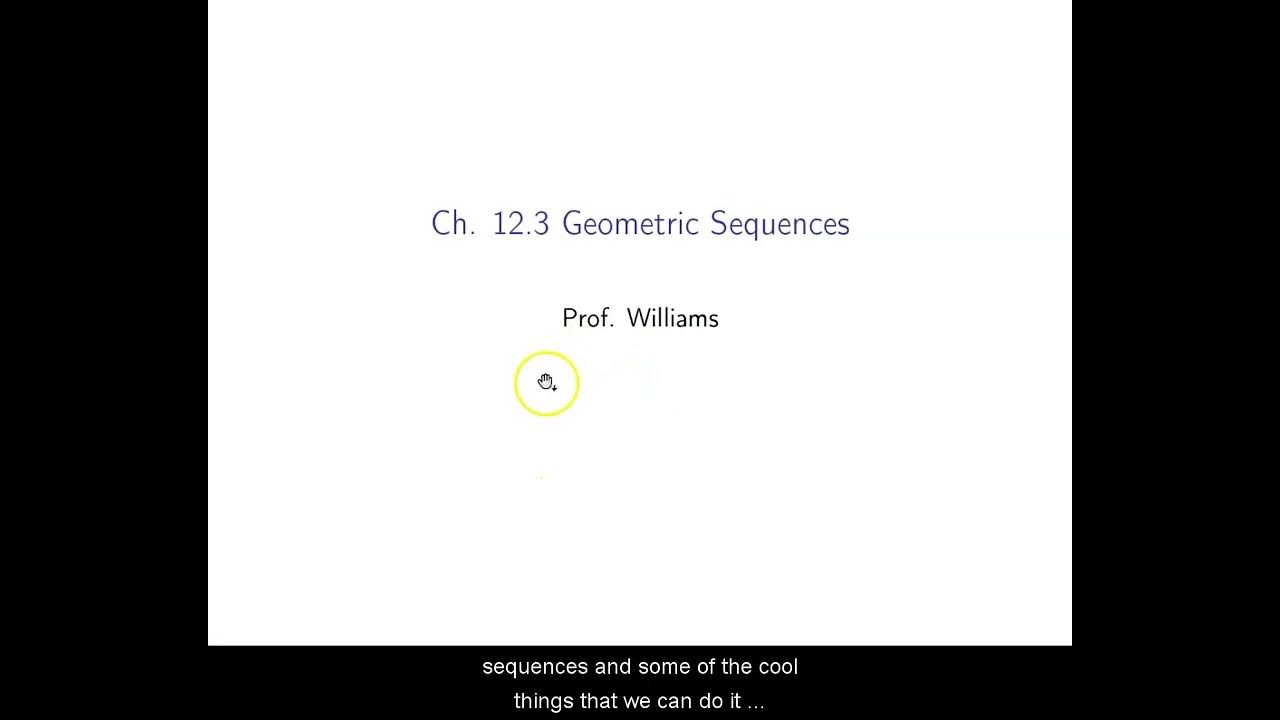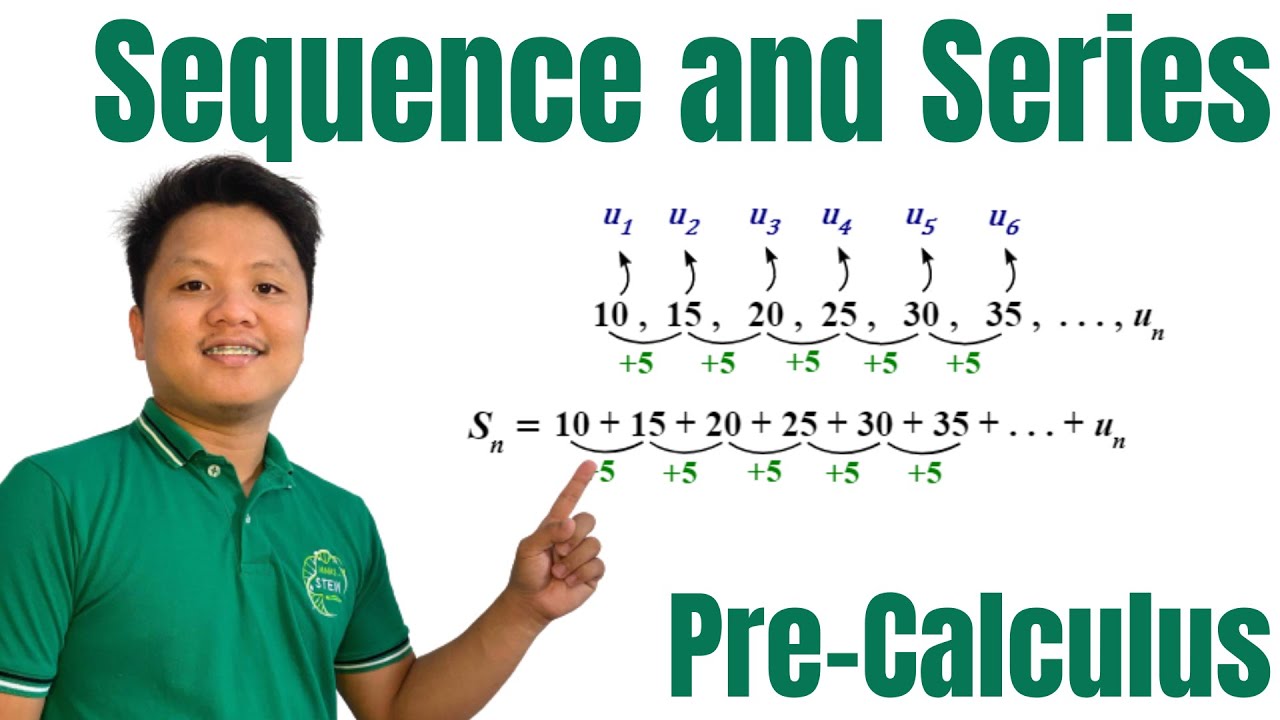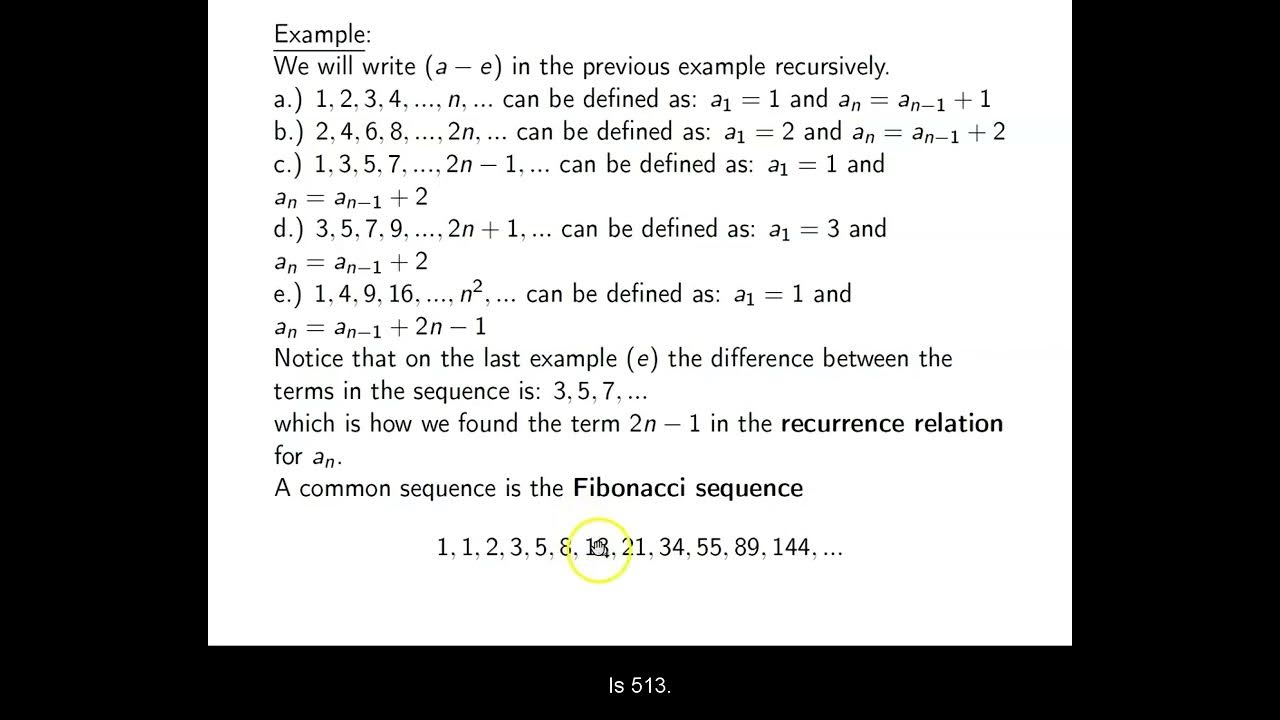Ch. 12.2 Arithmetic Sequences
TLDRThe lecture delves into arithmetic sequences, a type of mathematical sequence where each term is derived by adding a constant value to the previous term. The general formula is a + (n-1)d. The instructor explains how to identify and work with arithmetic sequences through examples, including determining unknown terms and sums of sequences. The lecture also discusses the story of Carl Gauss and how he quickly summed the first 100 integers, leading to the general formula for the nth partial sum of an arithmetic sequence.
Takeaways
- 📚 The script discusses Chapter 12.2 on arithmetic sequences, the first classification of sequences studied.
- 🔢 An arithmetic sequence is characterized by a constant difference, 'd', between consecutive terms, represented as a, a+d, a+2d, etc.
- 👉 The general term of an arithmetic sequence is given by a + (n-1)d, where 'a' is the first term and 'n' is the term number.
- 🔍 The script provides an example of an arithmetic sequence with a starting value 'a' and a common difference 'd', illustrating how to find subsequent terms.
- 📈 The concept of identifying an arithmetic sequence by the consistent change from one term to the next is explained.
- 🌰 An example sequence (3, 5, 7, 9, 11, ...) is given, with a starting value 'a' of 3 and a common difference 'd' of 2.
- 🧩 The script explains how to find the general term of an arithmetic sequence when given certain terms, using a system of equations.
- 📝 A method for finding the nth term using matrix operations or algebraic methods is demonstrated, including the use of inverse matrices.
- 📊 The script introduces the formula for the nth partial sum of an arithmetic sequence, relating it to the sum of the first 100 positive integers.
- 🎓 The story of Carl Frederick Gauss is recounted to illustrate a clever method for finding the sum of an arithmetic sequence without direct addition.
- 📐 The formula for the nth partial sum is derived as (n/2) * (2a + (n-1)d), showing how to find the sum of the first n terms of an arithmetic sequence.
Q & A
What is an arithmetic sequence?
-An arithmetic sequence is a sequence of numbers in which each term after the first is obtained by adding a constant value, d, to the previous term. It has the form a, a + d, a + 2d, a + 3d, and so on, where 'a' is the first term and 'd' is the common difference.
What is the general term of an arithmetic sequence?
-The general term of an arithmetic sequence is given by the formula a + (n - 1)d, where 'a' is the first term, 'd' is the common difference, and 'n' is the term number.
How can you identify an arithmetic sequence?
-An arithmetic sequence can be identified by the fact that the difference between consecutive terms is constant. If you change by the same amount from one value to the next in a sequence, it is an arithmetic sequence.
What is the common difference 'd' in the sequence 3, 5, 7, 9, 11, 13, 15, 17?
-The common difference 'd' in the given sequence is 2, as each term is obtained by adding 2 to the previous term.
How can you find the first term 'a' and the common difference 'd' of an arithmetic sequence if you know certain terms?
-If you know certain terms of an arithmetic sequence, you can set up a system of equations using the general term formula a + (n - 1)d for each term. Solving this system will give you the values of 'a' and 'd'.
What is the formula for the nth term of an arithmetic sequence in terms of the first term and the common difference?
-The formula for the nth term of an arithmetic sequence is a + (n - 1)d, where 'a' is the first term, 'd' is the common difference, and 'n' is the term number.
What is the nth partial sum of an arithmetic sequence?
-The nth partial sum of an arithmetic sequence is the sum of the first n terms. It can be found using the formula n/2 * (2a + (n - 1)d), where 'a' is the first term, 'd' is the common difference, and 'n' is the number of terms.
Who is Carl Frederick Gauss and what is the story about the sum of the first 100 positive integers?
-Carl Frederick Gauss was a famous mathematician. The story tells of a young Gauss who quickly calculated the sum of the first 100 positive integers by pairing each number with its complement to 100, summing to 100, and then multiplying by the number of pairs (50) and adding the middle number (50) to get the total sum of 5050.
How did Gauss find the sum of the first 100 integers without adding them individually?
-Gauss found the sum by recognizing that each pair of numbers from 1 to 100, where one number is added to its complement (100 minus the number), sums to 100. There are 50 such pairs, so he multiplied 50 by 100 and added the unpaired middle number, 50, to get the total sum of 5050.
What is the formula for the nth partial sum of an arithmetic sequence in terms of the first and last term?
-The formula for the nth partial sum of an arithmetic sequence in terms of the first term 'a' and the last term 'l' is n/2 * (a + l), where 'n' is the number of terms in the sequence.
How can you find the sum of an arithmetic series without writing out all the terms?
-You can find the sum of an arithmetic series without writing out all the terms by using the formula for the nth partial sum, which requires knowing the first term, the last term, and the number of terms in the series.
Outlines
📚 Introduction to Arithmetic Sequences
This paragraph introduces the concept of arithmetic sequences, which are a type of sequence where each term after the first is obtained by adding a constant value, 'd', to the previous term. The generalized term of an arithmetic sequence is described as 'a + (n-1)d', where 'a' is the first term and 'n' is the term number. The paragraph uses the example of even numbers to illustrate how the sequence progresses by consistently adding the value 'd'. It also explains how to identify an arithmetic sequence by the consistent change from one term to the next and provides a method to find the general term when given certain values from the sequence, using a system of equations and matrix operations to solve for the unknowns 'a' and 'd'.
🔢 The Sum of an Arithmetic Sequence
This paragraph delves into the concept of finding the sum of the first 'n' terms of an arithmetic sequence, using the story of Carl Friedrich Gauss to illustrate a clever method for summing numbers. It explains how Gauss rearranged the numbers from 1 to 100 to form pairs that sum to 100, thereby simplifying the calculation of the sum of the first 100 positive integers to 5050. The paragraph then generalizes this method to find the nth partial sum of an arithmetic sequence, which is given by the formula (n/2) * (first term + last term). It also explains how to find the last term of the sequence using the formula 'a + (n-1)d' and provides an example of summing a sequence with a starting value of 2 and a common difference of -3, calculating the sum to be -68.
📉 Summation of a Descending Arithmetic Sequence
The final paragraph continues the discussion on summing arithmetic sequences but focuses on a specific case where the sequence descends, with a starting value 'a' and a common difference 'd' that is negative. It provides an example where the sequence starts at 2 and decreases by 3 with each term, and the task is to find the sum of the first eight terms. The paragraph explains the process of identifying the necessary components for the summation formula, which includes the first term, the last term, and the number of terms. It then demonstrates the calculation of the sum, taking into account the negative common difference and the correct count of terms, resulting in a sum of -68 for the given sequence.
Mindmap
Keywords
💡Arithmetic Sequence
💡Generalized Term
💡Common Difference (d)
💡First Term (a)
💡Nth Term
💡Partial Sum
💡Sequence
💡System of Equations
💡Inverse Matrix
💡Summation
Highlights
Introduction to arithmetic sequences as the first classification of sequences in chapter 12.2.
Arithmetic sequence defined by a pattern of adding a constant value 'd' to each term.
Generalized term of an arithmetic sequence is a + (n - 1)d.
Explanation of how the first term 'a' does not include the value 'd'.
Identification of arithmetic sequences by consistent change from one term to the next.
Example of an arithmetic sequence with a starting value 'a' and common difference 'd'.
Method to find the next term in a sequence by adding the common difference 'd'.
Using given terms from a sequence to find the generalized term formula.
Solving a system of equations to find the first term 'a' and common difference 'd'.
Use of matrices to solve for 'a' and 'd' in an arithmetic sequence.
Explanation of the nth partial sum of an arithmetic sequence.
Story of Carl Friedrich Gauss and his method for adding the first 100 integers.
Gauss's technique of pairing numbers to find the sum of the first 100 integers.
Formula for the nth partial sum using the first and last term of the sequence.
Application of the formula to find the sum of an arithmetic sequence without writing out all terms.
Example calculation of the sum of an arithmetic sequence using the formula.
Explanation of the sequence's properties and how to find the last term using 'a', 'd', and 'n'.
Final calculation of the sum of the sequence using the provided formula and values.
Transcripts
Browse More Related Video

ILLUSTRATING SEQUENCES AND SERIES || PRECALCULUS

Ch. 12.3 Geometric Sequences

Geometric Sequences (Precalculus - College Algebra 71)

Arithmetic Sequences (Precalculus - College Algebra 69)

Sequence and Series | Terms of Sequence and Associated Series | Pre-Calculus

Ch. 12.1 Sequences and Summation Notation
5.0 / 5 (0 votes)
Thanks for rating: